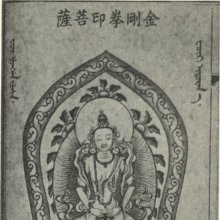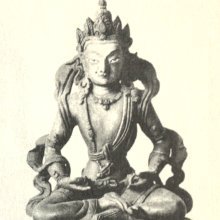Vajramushti, Vajra-mushti, Vajramuṣṭi, Vajramuṣṭī: 12 definitions
Introduction:
Vajramushti means something in Buddhism, Pali, Hinduism, Sanskrit, Marathi. If you want to know the exact meaning, history, etymology or English translation of this term then check out the descriptions on this page. Add your comment or reference to a book if you want to contribute to this summary article.
The Sanskrit terms Vajramuṣṭi and Vajramuṣṭī can be transliterated into English as Vajramusti or Vajramushti, using the IAST transliteration scheme (?).
Images (photo gallery)
In Hinduism
Kavya (poetry)
Source: Wisdom Library: Kathāsaritsāgara1) Vajramuṣṭi (वज्रमुष्टि) is the name of a Kṣatriya from the country Avanti, who later became friends with Śrīdatta, a Brāhman whose story is told in the “story of Śrīdatta and Mṛgāṅkavatī”, according to the Kathāsaritsāgara, chapter 10. Śrīdatta was the son of Kālanemi, who was the son of Yajñasoma, a Brāhman from the country of Mālava
2) Vajramuṣṭi (वज्रमुष्टि) is the name of a king allied to Devamāya who marched in war against Naravāhanadatta, as mentioned in the Kathāsaritsāgara, chapter 109. Accordingly, “... and Devamāya too, when he heard it, marched out towards him to give battle, accompanied by numerous kings, Varāha, Vajramuṣṭi, and others, and followed by his army. Then there took place on Kailāsa a battle between those two armies, and while it was going on the sky was obscured by the chariots of the gods, who came to look on.”.
The Kathāsaritsāgara (‘ocean of streams of story’), mentioning Vajramuṣṭi, is a famous Sanskrit epic story revolving around prince Naravāhanadatta and his quest to become the emperor of the vidyādharas (celestial beings). The work is said to have been an adaptation of Guṇāḍhya’s Bṛhatkathā consisting of 100,000 verses, which in turn is part of a larger work containing 700,000 verses.

Kavya (काव्य, kavya) refers to Sanskrit poetry, a popular ancient Indian tradition of literature. There have been many Sanskrit poets over the ages, hailing from ancient India and beyond. This topic includes mahakavya, or ‘epic poetry’ and natya, or ‘dramatic poetry’.
Purana and Itihasa (epic history)
Source: archive.org: Puranic EncyclopediaVajramuṣṭi (वज्रमुष्टि).—A giant. Vajramuṣṭi was the son born to Mālyavān of his wife Sundarī. Vajramuṣṭi had six brothers named Virūpākṣa, Durmukha, Suptaghna, Yajñakośa, Matta and Unmatta and a sister named Nalā. (Uttara Rāmāyaṇa).

The Purana (पुराण, purāṇas) refers to Sanskrit literature preserving ancient India’s vast cultural history, including historical legends, religious ceremonies, various arts and sciences. The eighteen mahapuranas total over 400,000 shlokas (metrical couplets) and date to at least several centuries BCE.
In Buddhism
Tibetan Buddhism (Vajrayana or tantric Buddhism)
Source: Wisdom Library: MañjuśrīnāmasaṃgītiVajramuṣṭi (वज्रमुष्टि) is one of the sixteen samādhi deities appearing in the Vajradhātu-mahāmaṇḍala, according to the Nāmamantrārthāvalokinī v5.32-35. The Nāmamantrārthāvalokinī (literally, ‘an explanation of the nāma-mantras’) is a commentary (ṭīkā) on the 8th century Mañjuśrīnāmasaṃgīti.
Vajramuṣṭi is a name of Mañjuśrī (the embodiement of non-dual knowledge) and, together with other names, forms the core essence of the Mañjuśrīnāmasaṃgīti. The Nāmamantrārthāvalokinī provides the practitioner a sādhana (‘meditative practice’) to turn these names into mantras. These mantras are chanted for the benefit of all beings, and then placed and contemplated in the Vajradhātu-mahāmaṇḍala, which is an extended version of the Vajradhātu-maṇḍala.
Source: Wisdom Library: Tibetan BuddhismVajramuṣṭī (वज्रमुष्टी) is the name of Dūtī (i.e., messengers of Lord Vajrapāṇi) mentioned as attending the teachings in the 6th century Mañjuśrīmūlakalpa: one of the largest Kriyā Tantras devoted to Mañjuśrī (the Bodhisattva of wisdom) representing an encyclopedia of knowledge primarily concerned with ritualistic elements in Buddhism. The teachings in this text originate from Mañjuśrī and were taught to and by Buddha Śākyamuni in the presence of a large audience (including Vajramuṣṭī).

Tibetan Buddhism includes schools such as Nyingma, Kadampa, Kagyu and Gelug. Their primary canon of literature is divided in two broad categories: The Kangyur, which consists of Buddha’s words, and the Tengyur, which includes commentaries from various sources. Esotericism and tantra techniques (vajrayāna) are collected indepently.
Languages of India and abroad
Marathi-English dictionary
Source: DDSA: The Molesworth Marathi and English Dictionaryvajramuṣṭi (वज्रमुष्टि).—m S A weapon of the athletæ. 2 f m An iron or a hard fist. Used in both senses attributively. 3 f also vajramūṭha f Wild and bitter suraṇa q. v.
Source: DDSA: The Aryabhusan school dictionary, Marathi-Englishvajramuṣṭi (वज्रमुष्टि).—m A weapon of the athlete. f m An iron or a hard fist.
Marathi is an Indo-European language having over 70 million native speakers people in (predominantly) Maharashtra India. Marathi, like many other Indo-Aryan languages, evolved from early forms of Prakrit, which itself is a subset of Sanskrit, one of the most ancient languages of the world.
Sanskrit dictionary
Source: DDSA: The practical Sanskrit-English dictionaryVajramuṣṭi (वज्रमुष्टि).—
1) an epithet of Indra.
2) an adamantine clenched fist.
3) a kind of weapon.
Derivable forms: vajramuṣṭiḥ (वज्रमुष्टिः).
Vajramuṣṭi is a Sanskrit compound consisting of the terms vajra and muṣṭi (मुष्टि).
Source: Cologne Digital Sanskrit Dictionaries: Edgerton Buddhist Hybrid Sanskrit DictionaryVajramuṣṭi (वज्रमुष्टि).—name of a kiṃnara maid: Kāraṇḍavvūha 6.4.
Source: Cologne Digital Sanskrit Dictionaries: Cappeller Sanskrit-English DictionaryVajramuṣṭi (वज्रमुष्टि).—[adjective] holding a thunderbolt in the fist, [Epithet] of Indra, [Name] of a Rākṣasa & [several] warriors.
Source: Cologne Digital Sanskrit Dictionaries: Monier-Williams Sanskrit-English Dictionary1) Vajramuṣṭi (वज्रमुष्टि):—[=vajra-muṣṭi] [from vajra > vaj] m. ‘grasping a th°’, or ‘one whose clenched fist is like adamant’, Name of Indra, [Rāmāyaṇa]
2) [v.s. ...] of a Rākṣasa, [ib.]
3) [v.s. ...] of a Kṣatriya or warrior, [Kathāsaritsāgara]
4) [v.s. ...] mf. an adamantine clenched fist or a kind of weapon, [Harivaṃśa]
5) [v.s. ...] Name of a Gaṇa of Śiva, [ib.]
6) [v.s. ...] f. a [particular] position of the hand in shooting an arrow, [Śārṅgadhara-paddhati]
[Sanskrit to German]
Sanskrit, also spelled संस्कृतम् (saṃskṛtam), is an ancient language of India commonly seen as the grandmother of the Indo-European language family (even English!). Closely allied with Prakrit and Pali, Sanskrit is more exhaustive in both grammar and terms and has the most extensive collection of literature in the world, greatly surpassing its sister-languages Greek and Latin.
Kannada-English dictionary
Source: Alar: Kannada-English corpusVajramuṣṭi (ವಜ್ರಮುಷ್ಟಿ):—
1) [noun] a kind of hand-weapon.
2) [noun] Indra, the chief of gods, who uses thunderbolt as his weapon.
3) [noun] (fig.) a very firm hold, control.
Kannada is a Dravidian language (as opposed to the Indo-European language family) mainly spoken in the southwestern region of India.
See also (Relevant definitions)
Partial matches: Mushti, Vajra.
Query error!
Full-text: Samarpinem, Sundari, Jyesthimalla, Matta, Mahabahu, Tikshnadamshtra, Varaha, Unmatta, Shridatta, Virupaksha, Durmukha.
Relevant text
Search found 8 books and stories containing Vajramushti, Vajra-mushti, Vajra-muṣṭi, Vajra-musti, Vajramuṣṭi, Vajramusti, Vajramuṣṭī; (plurals include: Vajramushtis, mushtis, muṣṭis, mustis, Vajramuṣṭis, Vajramustis, Vajramuṣṭīs). You can also click to the full overview containing English textual excerpts. Below are direct links for the most relevant articles:
Ramayana of Valmiki (by Hari Prasad Shastri)
Chapter 43 - The Conflict between the Monkeys and Titans < [Book 6 - Yuddha-kanda]
Chapter 5 - The Story of the three Sons of Sukesha < [Book 7 - Uttara-kanda]
Puranic encyclopaedia (by Vettam Mani)
Guhyagarbha Tantra (with Commentary) (by Gyurme Dorje)
Text 11.17 (Commentary) < [Chapter 11 (Text and Commentary)]
Introduction 3.2.2: The Sequence of the actual Foundation of Empowerment < [Chapter 9 (Text And Commentary)]
Kathasaritsagara (cultural study) (by S. W. Chitale)
House-hold-Articles in ancient India < [Chapter 4 - Social Conditions]
Description of ancient Indian Agriculture < [Chapter 3 - Economic Conditions]
Yoga Vasistha [English], Volume 1-4 (by Vihari-Lala Mitra)
Chapter xxxvi < [Book III - Utpatti khanda (utpatti khanda)]
Kathasaritsagara (the Ocean of Story) (by Somadeva)
Related products

